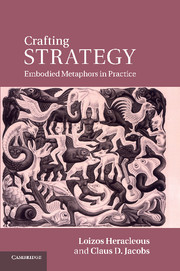Book contents
- Frontmatter
- Contents
- List of figures
- List of tables
- Preface
- Acknowledgments
- Vignette A BASF PerForm
- Vignette B UNICEF
- Vignette C Project Voltigo
- Vignette D Hephata Foundation
- 6 Understanding organizations through embodied metaphors
- 7 Sensemaking through embodied metaphors in organization development
- Vignette E Privatbank IHAG Zürich AG
- Vignette F World Vision New Zealand
- Glossary
- Index
- References
7 - Sensemaking through embodied metaphors in organization development
Published online by Cambridge University Press: 05 June 2011
- Frontmatter
- Contents
- List of figures
- List of tables
- Preface
- Acknowledgments
- Vignette A BASF PerForm
- Vignette B UNICEF
- Vignette C Project Voltigo
- Vignette D Hephata Foundation
- 6 Understanding organizations through embodied metaphors
- 7 Sensemaking through embodied metaphors in organization development
- Vignette E Privatbank IHAG Zürich AG
- Vignette F World Vision New Zealand
- Glossary
- Index
- References
Summary
In this chapter we illustrate how embodied metaphorical mapping can be effectively employed in organization development (OD) interventions. Conceptually, we suggest that an embodied metaphor approach complements and extends the traditionally deductively oriented approaches to employment of metaphor in organization development. This is accomplished by emphasizing induced rather than naturally occurring metaphors, building on a developed base of diagnostic technologies, enabling a collaborative effort of metaphorical selection and diagnosis, and enabling the employment of embodied metaphors to address specific, targeted issues of consequence to participants. We illustrate these considerations by discussing the case of a management retreat of a Swiss bank.
Sensemaking through embodied metaphors
As outlined in Chapter 2, we view metaphors as conceptual constructions that play a central role in the development of thought and inter-subjective meaning-making. Furthermore, and in line with social constructionism, we concur with the view that correspondence between source and target domain may be created, rather than just revealed (Black, 1979), making metaphor a prime means of gaining new perspectives on existing challenges. This generative potential of metaphors in terms of allowing for novel perceptions, explanations and inventions has been acknowledged in organization development (Burke, 1992; Marshak, 1993) but not extensively utilized. In addition to their generative potential, metaphors provide lenses for interpreting the world, embodying implicit evaluations and helping to concretize vague or abstract ideas (Armenakis and Bedeian, 1992; Hirsch, 1986).
- Type
- Chapter
- Information
- Crafting StrategyEmbodied Metaphors in Practice, pp. 156 - 172Publisher: Cambridge University PressPrint publication year: 2011



